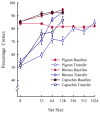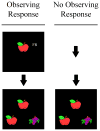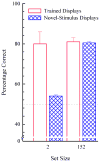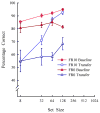Issues in the Comparative Cognition of Abstract-Concept Learning
- PMID: 20228966
- PMCID: PMC2836729
- DOI: 10.3819/ccbr.2008.20005
Issues in the Comparative Cognition of Abstract-Concept Learning
Abstract
-concept learning, including same/different and matching-to-sample concept learning, provides the basis for many other forms of "higher" cognition. The issue of which species can learn abstract concepts and the extent to which abstract-concept learning is expressed across species is discussed. Definitive answers to this issue are argued to depend on the subjects' learning strategy (e.g., a relational-learning strategy) and the particular procedures used to test for abstract-concept learning. Some critical procedures that we have identified are: How to present the items to-be-compared (e.g., in pairs), a high criterion for claiming abstract-concept learning (e.g., transfer performance equivalent to baseline performance), and systematic manipulation of the training set (e.g., increases in the number of rule exemplars when transfer is less than baseline performance). The research covered in this article on the recent advancements in abstract-concept learning show this basic ability in higher-order cognitive processing is common to many animal species and that "uniqueness" may be limited more to how quickly new abstract concepts are learned rather than to the ability itself.
Figures











Similar articles
-
Matching-to-sample abstract-concept learning by pigeons.J Exp Psychol Anim Behav Process. 2008 Jan;34(1):178-84. doi: 10.1037/0097-7403.34.1.178. J Exp Psychol Anim Behav Process. 2008. PMID: 18248124
-
Superior abstract-concept learning by Clark's nutcrackers (Nucifraga columbiana).Biol Lett. 2015 May;11(5):20150148. doi: 10.1098/rsbl.2015.0148. Biol Lett. 2015. PMID: 25972399 Free PMC article.
-
Abstract-concept learning in Black-billed magpies (Pica hudsonia).Psychon Bull Rev. 2017 Apr;24(2):431-435. doi: 10.3758/s13423-016-1132-4. Psychon Bull Rev. 2017. PMID: 27503195
-
Second verse, same as the first: learning generalizable relational concepts through functional repetition.Anim Cogn. 2023 Jan;26(1):141-151. doi: 10.1007/s10071-022-01702-9. Epub 2022 Oct 12. Anim Cogn. 2023. PMID: 36222938 Review.
-
Comparing cognition by integrating concept learning, proactive interference, and list memory.Learn Behav. 2018 Jun;46(2):107-123. doi: 10.3758/s13420-018-0316-3. Learn Behav. 2018. PMID: 29492785 Review.
Cited by
-
Abstraction, Multiple Exemplar Training and the Search for Derived Stimulus Relations in Animals.Perspect Behav Sci. 2017 Nov 1;41(1):45-67. doi: 10.1007/s40614-017-0112-y. eCollection 2018 Jun. Perspect Behav Sci. 2017. PMID: 32004363 Free PMC article.
-
Associative concept learning in animals.J Exp Anal Behav. 2014 Jan;101(1):130-51. doi: 10.1002/jeab.55. Epub 2013 Oct 29. J Exp Anal Behav. 2014. PMID: 24170540 Free PMC article. Review.
-
Self-control depletion in tufted capuchin monkeys (Sapajus spp.): does delay of gratification rely on a limited resource?Front Psychol. 2015 Aug 11;6:1193. doi: 10.3389/fpsyg.2015.01193. eCollection 2015. Front Psychol. 2015. PMID: 26322001 Free PMC article.
-
Feature- versus rule-based generalization in rats, pigeons and humans.Anim Cogn. 2015 Nov;18(6):1267-84. doi: 10.1007/s10071-015-0895-8. Epub 2015 Jul 19. Anim Cogn. 2015. PMID: 26188712 Free PMC article.
-
Methodological Considerations in Canine Olfactory Detection Research.Front Vet Sci. 2020 Jul 17;7:408. doi: 10.3389/fvets.2020.00408. eCollection 2020. Front Vet Sci. 2020. PMID: 32766296 Free PMC article. Review.
References
-
- Bitterman ME. Phyletic differences in learning. American Psychologist. 1965;20:396–410. - PubMed
-
- Bitterman ME. The comparative analysis of learning. Science. 1975;188:699–709. - PubMed
-
- Blaisdell AP, Cook RG. Two-item same-different concept learning in pigeons. Learning & Behavior. 2005;33:67–77. - PubMed
-
- Bovet D, Vauclair J. Judgment of conceptual identity in monkeys. Psychonomic Bulletin & Review. 2001;8:470–475. - PubMed
-
- Carter DE, Eckerman DA. Symbolic matching by pigeons: Rate of learning complex discriminations predicted from simple discriminations. Science. 1975;187:662–664. - PubMed
Grants and funding
LinkOut - more resources
Full Text Sources
